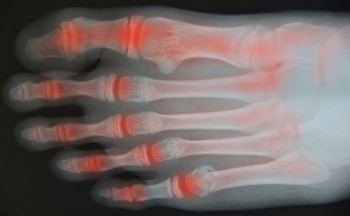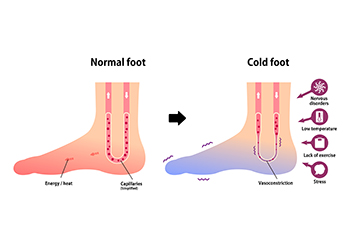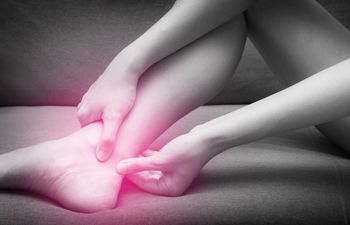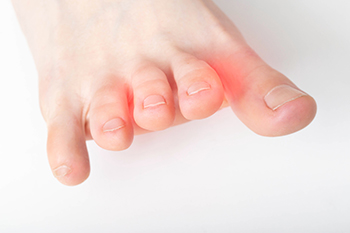Items filtered by date: February 2023
Joint Soreness in the Feet With Rheumatoid Arthritis

Having sore feet is common with the foot condition that is known as rheumatoid arthritis. It can happen to any joint in the body, and walking can become difficult when it affects the feet. It is considered to be a disease, and it causes the membranes and joints to become swollen and inflamed. Research has shown that approximately 90 percent of people with this condition have foot pain, and the symptoms can include tenderness, stiffness, and the joints may feel warm when touched. If the ankle joints are affected, early detection can consist of having difficulty in walking up or down steps, or inclines, such as hills or ramps. Mild relief may be found when stretches are performed that can help to increase flexibility. Practicing a gentle yoga routine may help to achieve this goal. If you have rheumatoid arthritis, it is suggested that you contact a podiatrist who can monitor your feet and offer you additional relief options.
Because RA affects more than just your joints, including the joints in your feet and ankles, it is important to seek early diagnosis from your podiatrist if you feel like the pain in your feet might be caused by RA. For more information, contact Shawn Echard, DPM of Laurel Podiatry LLC. Our practitioner will assist you with all of your podiatric concerns.
What Is Rheumatoid Arthritis?
Rheumatoid Arthritis (RA) is an autoimmune disorder in which the body’s own immune system attacks the membranes surrounding the joints. Inflammation of the lining and eventually the destruction of the joint’s cartilage and bone occur, causing severe pain and immobility.
Rheumatoid Arthritis of the Feet
Although RA usually attacks multiple bones and joints throughout the entire body, almost 90 percent of cases result in pain in the foot or ankle area.
Symptoms
- Swelling and pain in the feet
- Stiffness in the feet
- Pain on the ball or sole of feet
- Joint shift and deformation
Diagnosis
Quick diagnosis of RA in the feet is important so that the podiatrist can treat the area effectively. Your doctor will ask you about your medical history, occupation, and lifestyle to determine the origin of the condition. Rheumatoid Factor tests help to determine if someone is affected by the disease.
If you have any questions please feel free to contact our offices located in Greensburg and Somerset, PA . We offer the newest diagnostic and treatment technologies for all your foot and ankle needs.
Symptoms of Peripheral Artery Disease

There is a condition known as peripheral artery disease, which is abbreviated as PAD. This produces decreased blood flow in the feet and legs, possibly causing injuries to the nerves and tissues. PAD can happen due to a plaque build-up in the arteries, causing them to become narrow. This can affect the blood flow to the legs since there is limited blood flow and oxygen supply. There are existing medical conditions that may lead to PAD, including kidney disease, high blood pressure, and diabetes. The symptoms that are often associated with PAD can consist of foot pain, a numbing sensation, and sores that are slow in healing. Peripheral artery disease may be controlled by eating properly, resting, and taking proper care of the feet. Additionally, it is beneficial to stop smoking, if it applies, and it is helpful to monitor blood sugar levels. Uncomfortable foot conditions from PAD are treated by a podiatrist, and it is advised that you contact this type of doctor who can provide you with the correct treatment methods.
Peripheral artery disease can pose a serious risk to your health. It can increase the risk of stroke and heart attack. If you have symptoms of peripheral artery disease, consult with Shawn Echard, DPM from Laurel Podiatry LLC. Our practitioner will assess your condition and provide you with quality foot and ankle treatment.
Peripheral artery disease (PAD) is when arteries are constricted due to plaque (fatty deposits) build-up. This results in less blood flow to the legs and other extremities. The main cause of PAD is atherosclerosis, in which plaque builds up in the arteries.
Symptoms
Symptoms of PAD include:
- Claudication (leg pain from walking)
- Numbness in legs
- Decrease in growth of leg hair and toenails
- Paleness of the skin
- Erectile dysfunction
- Sores and wounds on legs and feet that won’t heal
- Coldness in one leg
It is important to note that a majority of individuals never show any symptoms of PAD.
Diagnosis
While PAD occurs in the legs and arteries, Podiatrists can diagnose PAD. Podiatrists utilize a test called an ankle-brachial index (ABI). An ABI test compares blood pressure in your arm to you ankle to see if any abnormality occurs. Ultrasound and imaging devices may also be used.
Treatment
Fortunately, lifestyle changes such as maintaining a healthy diet, exercising, managing cholesterol and blood sugar levels, and quitting smoking, can all treat PAD. Medications that prevent clots from occurring can be prescribed. Finally, in some cases, surgery may be recommended.
If you have any questions, please feel free to contact our offices located in Greensburg and Somerset, PA . We offer the newest diagnostic and treatment technologies for all your foot care needs.
Several Reasons for an Achilles Tendon Injury

The Achilles tendon is located in the calf, and when injured, it can become extremely painful. This tendon connects the heel to the calf muscles and is the largest tendon in the body. An injury to this tendon can make it difficult, if not impossible, to walk, and prompt medical attention is often sought. An Achilles tendon injury can occur from gradual overuse, and it may be common in people who increase speed and distance too quickly while running. The symptoms that many people experience with this type of injury can include pain at the back of the heel, and the affected area may be warm and tender. There may be additional reasons why this condition may happen. These can consist of being overweight, wearing shoes that do not fit properly, or possibly having flat feet. If you have pain in this part of your foot, it is strongly urged that you are under the care of a podiatrist who can perform a diagnosis, and offer correct treatment options.
Achilles tendon injuries need immediate attention to avoid future complications. If you have any concerns, contact Shawn Echard, DPM of Laurel Podiatry LLC. Our practitioner can provide the care you need to keep you pain-free and on your feet.
What Is the Achilles Tendon?
The Achilles tendon is a tendon that connects the lower leg muscles and calf to the heel of the foot. It is the strongest tendon in the human body and is essential for making movement possible. Because this tendon is such an integral part of the body, any injuries to it can create immense difficulties and should immediately be presented to a doctor.
What Are the Symptoms of an Achilles Tendon Injury?
There are various types of injuries that can affect the Achilles tendon. The two most common injuries are Achilles tendinitis and ruptures of the tendon.
Achilles Tendinitis Symptoms
- Inflammation
- Dull to severe pain
- Increased blood flow to the tendon
- Thickening of the tendon
Rupture Symptoms
- Extreme pain and swelling in the foot
- Total immobility
Treatment and Prevention
Achilles tendon injuries are diagnosed by a thorough physical evaluation, which can include an MRI. Treatment involves rest, physical therapy, and in some cases, surgery. However, various preventative measures can be taken to avoid these injuries, such as:
- Thorough stretching of the tendon before and after exercise
- Strengthening exercises like calf raises, squats, leg curls, leg extensions, leg raises, lunges, and leg presses
If you have any questions please feel free to contact our offices located in Greensburg and Somerset, PA . We offer the newest diagnostic tools and technology to treat your foot and ankle needs.
Injury From a Winter Sport? Get the Care You Need
I Feel Like I Am Walking on a Rock and It Hurts

Morton’s neuroma is when a benign tumor grows in the nerve cells in the forefoot, causing pain or irritation. It impacts the nerve under the toe bones, usually between the third and fourth toes. Morton's neuroma can originate from irritation, trauma, or excessive pressure on the nerves in the forefoot. Wearing ill-fitting shoes that are too tight in the toe area and compress the forefoot and toes is one such cause. Wearing high-heeled shoes that increase pressure on the forefoot, causing the toes to be jammed into the toe box, is another. Repetitive force on the forefoot from exercises like running, and court or racket sports is yet another cause of this affliction. When one has a Morton’s neuroma, they will often experience burning, shooting, or stabbing pain in the ball of the foot. It will feel like a pebble is under the foot, and there will be numbness, tingling, or discomfort in the toes. If you feel you might have a Morton’s neuroma, see a podiatrist who will examine your foot and if needed, order imaging tests to confirm the diagnosis before recommending treatment that is right for you.
Morton’s neuroma is a very uncomfortable condition to live with. If you think you have Morton’s neuroma, contact Shawn Echard, DPM of Laurel Podiatry LLC. Our practitioner will attend to all of your foot care needs and answer any of your related questions.
Morton’s Neuroma
Morton's neuroma is a painful foot condition that commonly affects the areas between the second and third or third and fourth toe, although other areas of the foot are also susceptible. Morton’s neuroma is caused by an inflamed nerve in the foot that is being squeezed and aggravated by surrounding bones.
What Increases the Chances of Having Morton’s Neuroma?
- Ill-fitting high heels or shoes that add pressure to the toe or foot
- Jogging, running or any sport that involves constant impact to the foot
- Flat feet, bunions, and any other foot deformities
Morton’s neuroma is a very treatable condition. Orthotics and shoe inserts can often be used to alleviate the pain on the forefront of the feet. In more severe cases, corticosteroids can also be prescribed. In order to figure out the best treatment for your neuroma, it’s recommended to seek the care of a podiatrist who can diagnose your condition and provide different treatment options.
If you have any questions, please feel free to contact our offices located in Greensburg and Somerset, PA . We offer the newest diagnostic and treatment technologies for all your foot care needs.

